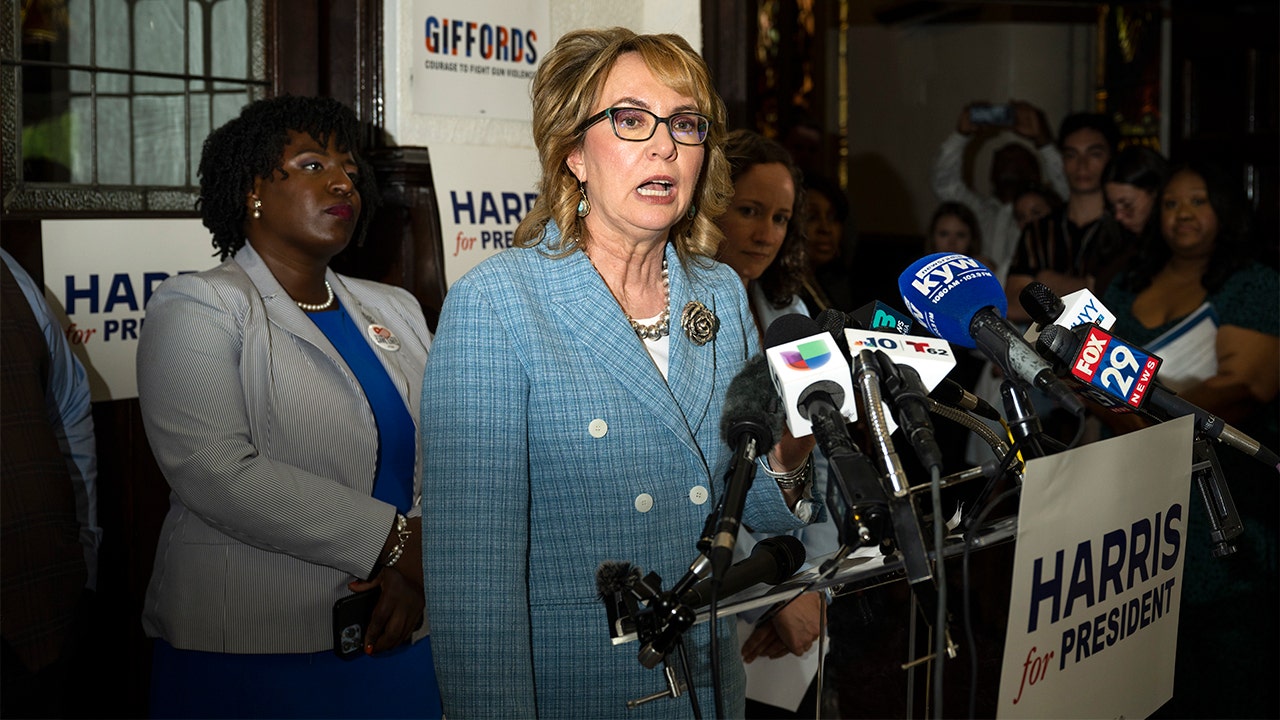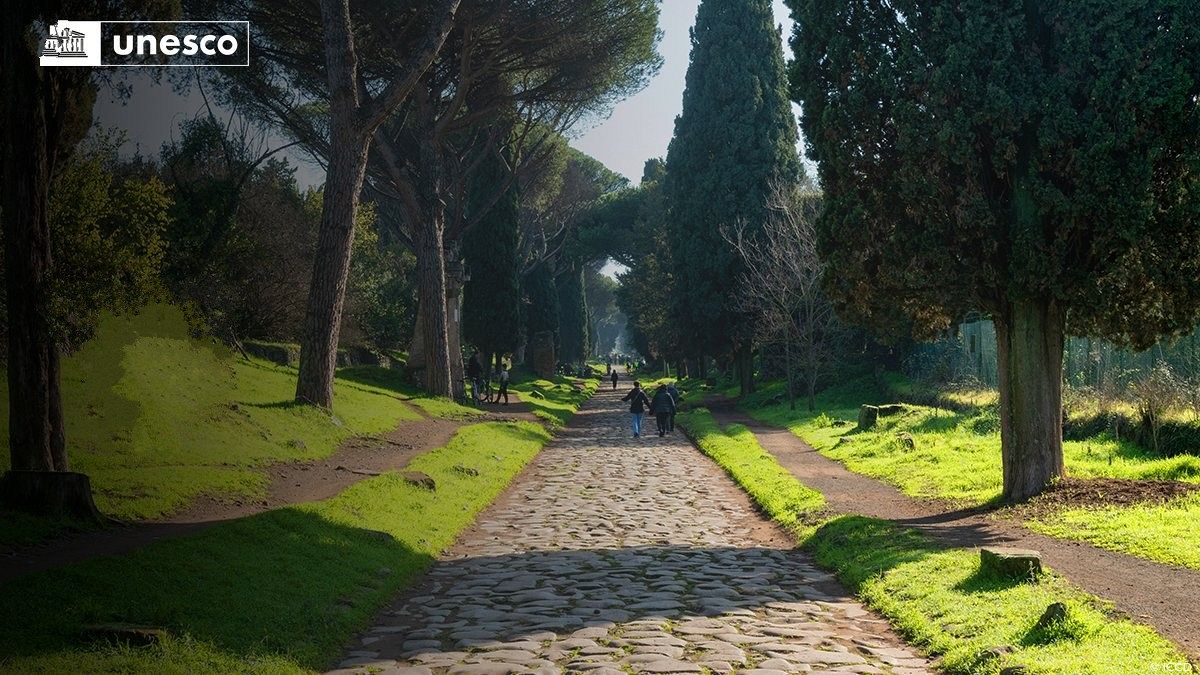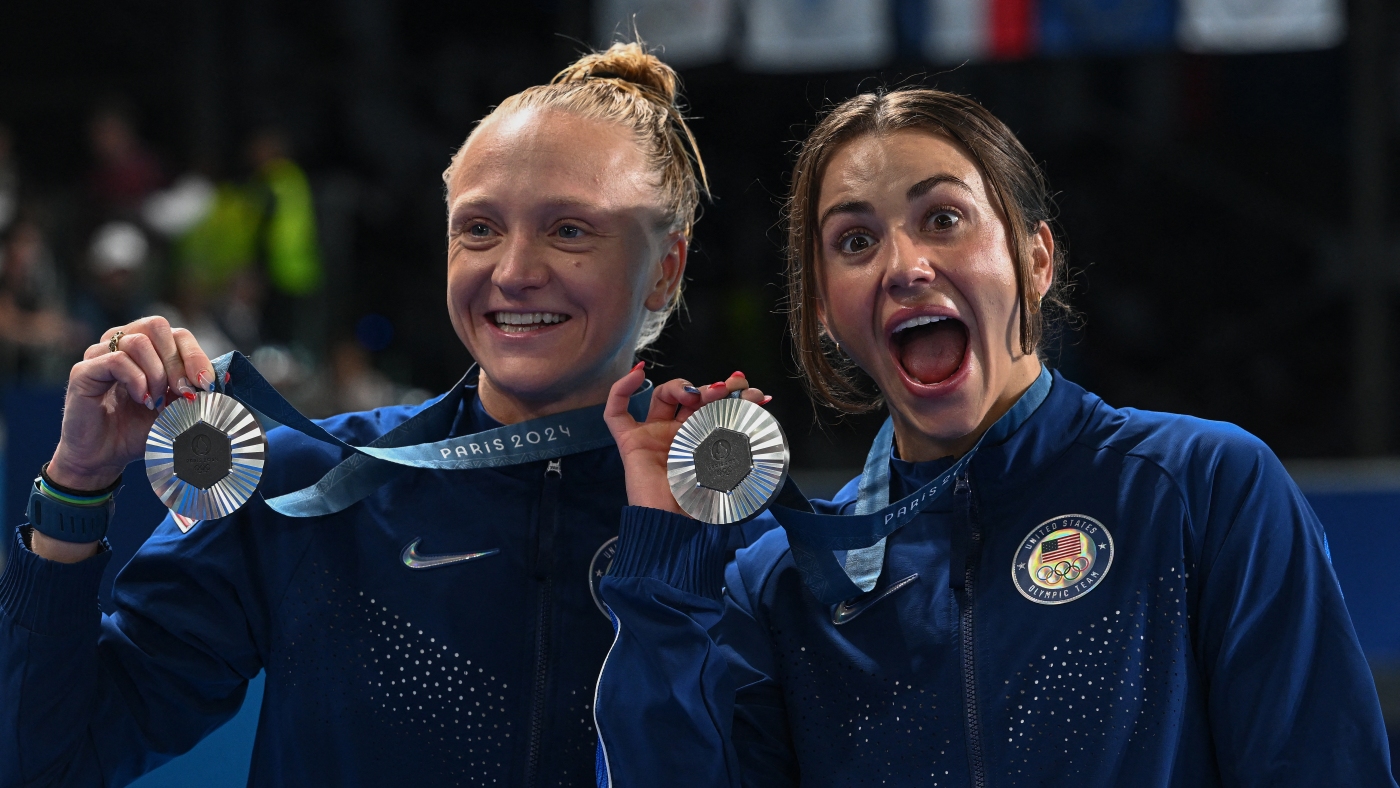Sports
Caitlin Clark's WNBA debut overshadowed by record turnover night: 'We’ve got to help her out'
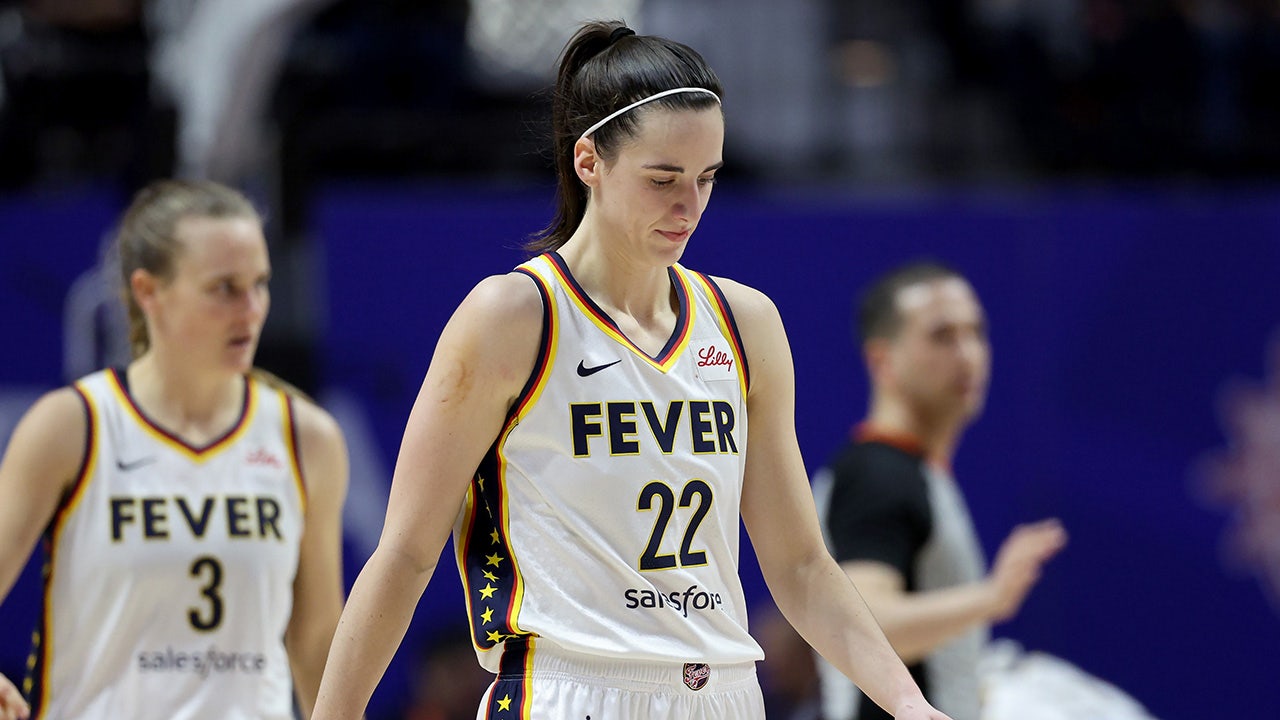
Caitlin Clark recorded history in her WNBA debut on Tuesday night, although it wasn’t a stat the Indiana Fever were hoping to accomplish.
Clark’s reputation as a prolific shooter didn’t translate well in her first regular season game, as the Connecticut Sun were able to limit her early on in their 92-71 victory at home. The former Iowa Hawkeyes’ star led the team with 20 points but was 5 of 15 from the field, including 4 of 11 from deep.
Caitlin Clark of the Indiana Fever controls the ball, defended by DiJonai Carrington of the Sun, at Mohegan Sun Arena on May 14, 2024 in Uncasville, Connecticut. (Elsa/Getty Images)
Most notable was the Fever’s high turnover rate. Clark herself turned over the ball 10 times, marking the most of any player making their career debut in the WNBA. That record was previously set by Cynthia Cooper-Dyke when she had eight.
“We don’t have a lot of practice time for our next one,” Fever coach Christie Sides said of Indiana’s quick turnaround to host the New York Liberty on Thursday night.
“We’ll be in the gym tomorrow watching a lot of video, trying to figure out how not to turn the ball over 25 times for 29 points.”
But Sides did not place the blame entirely on Clark.

Caitlin Clark of the Indiana Fever looks on from the bench during the Sun game at Mohegan Sun Arena on May 14, 2024, in Uncasville, Connecticut. (Elsa/Getty Images)
CONNECTICUT SUN ROUT INDIANA FEVER TO SPOIL CAITLIN CLARK’S WNBA DEBUT
“We’ve got to help her out. We’ve got to do a better job of coming back to the ball. We worked on that several times this week, just knowing that that was probably going to be what they were going to do,” she continued.
“But we just have to do a better job of getting somebody back to the ball.”
For her role, Clark said after the game she won’t harp on the negative.
“I’m disappointed, and nobody likes to lose, but I don’t think you can beat yourself up too much about one game,” Clark said. “I don’t think that’s going to help this team.”

Caitlin Clark of the Indiana Fever reacts during the second quarter against the Sun at Mohegan Sun Arena on May 14, 2024, in Uncasville, Connecticut. (Elsa/Getty Images)
The Fever will have to adjust without any time on the court, Sides lamented on Tuesday night.
“There’s just so much that we need to work on, and this league – it’s not very kind to us right now with our schedule and what we have coming up next. To have to watch video and not be able to go out and work on something, it’s two different things.”
“It’s us trying to figure out how we can change and fix what we need to in 24 hours without a practice.”
Follow Fox News Digital’s sports coverage on X, and subscribe to the Fox News Sports Huddle newsletter.

Sports
Explained: The rules for under-18s competing in the Paris Olympics

As the eyes of the sporting world turn to host city Paris, extra focus will fall on the hundreds of children competing at the 2024 Olympic Games.
While some sports — including diving, gymnastics, wrestling and boxing — have minimum ages for when athletes can take part, others, such as skateboarding, surfing and table tennis, have no restrictions.
Skateboarding, which made its Olympics debut at the Tokyo Games in 2021 (delayed a year because of the Covid-19 pandemic), attracts a particularly young field, with Finland’s Heili Sirvio and Hasegawa Mizuho of Japan, who are 13, and Zheng Haohao, a Chinese athlete who is just 11 years old, appearing in the French capital.
So what are the rules on under-18s performing at the Games? How do these differ between various sports? Where do these children stay and how are they looked after?
What is the minimum age requirement for the Olympics?
There is no specific age limit to compete at the Games. Age restrictions are set by the international federations in charge of each sport, rather than the International Olympic Committee (IOC).
Arguably the most famous performance by a child at the Olympics was Romanian gymnast Nadia Comaneci receiving a series of perfect 10 scores from the judges at the 1976 Montreal Games when she was 14.
Comaneci was 14 when received a perfect score at the 1976 Olympics (AFP via Getty Images)
Several Olympic sports have no age restrictions, at either end of the scale. In skateboarding at these Games, for example, Great Britain & Northern Ireland have 16-year-olds Sky Brown and Lola Tambling competing alongside Andy Macdonald, who turns 51 next week.
However, for most other sports, there is a minimum age. For example, female gymnasts must now be at least 16 — and there have been growing calls for that to be raised to 18, in line with their male equivalents — while divers must be at least 14, as was the case with Team GB’s Tom Daley at the 2008 Olympics in Beijing, China. In judo, it’s 14, and in wrestling it’s 18.
In boxing, the minimum age is 19 and the maximum is 39. Special permission was given to Finland’s Mira Potkonen who was 40 in Tokyo after the Olympics were delayed by a year due to the pandemic. She went on to finish third in the women’s lightweight category, becoming the oldest boxer to win a medal at the Games.
The men’s football event is essentially an under-23s competition, but each 18-strong squad is allowed three overage members.
In the UK, athletes have to be at least 20 for marathons/race-walking and 18 to take part in throwing events, the heptathlon and decathlon and the 10,000m. Athletes as young as 16 can appear in other track events so long as they have “demonstrated a consistent level of performance, as well as previous experience at major international competition, which suggests that selection for senior competition is appropriate for their long-term development”.
In Paris, this is set to include 17-year-old Phoebe Gill in the women’s 800m. She could become the youngest British track athlete at an Olympics for more than 40 years.
How are child athletes protected at the Games?
At the Tokyo Olympics, the IOC brought in chaperones for under-16 athletes.
This time, the IOC is encouraging each national team to have a safeguarding officer and is offering two extra accreditations for welfare officers.
Athletes aged under 18 are allowed to stay at the Olympic Village, home to around 10,000 competitors across the Games, situated in the Saint-Denis area of northern Paris, near the Stade de France. However, whether they actually do so is down to each individual country.

Athletes under 18 will have to pair up with a buddy when they walk around the Olympic Village (Maja Hitij/Getty Images)
Scott Field, director of communications for Team GB, explained how careful attention is being paid to who their youngest athletes share a room with.
“We have a welfare plan that dictates how sports should manage where and who athletes room with, in the Olympic Village or other accommodation,” Field told The Athletic. “Under-16s would have a chaperone with them, who must also accompany them when outside of the Olympic Village/their satellite accommodation.
“We have an extensive welfare guide that supports young people in their stay at the Olympics. We also have a dedicated group of designated safeguarding officers who are on hand to provide welfare support throughout the Games.”
Australia has decided the three youngest athletes in its 460-strong team — Arisa Trew and Chloe Covell, both 14, and 15-year-old Ruby Trew, who are all skateboarders — will stay in a hotel rather than the athletes’ village, UK newspaper The Guardian has reported.
Those under-18s who are in the Olympic village will not share a bedroom with an adult. The apartments will have a supervisor, and the under-18s will have to pair up with a buddy when they walk around the athletes’ village. They will have a supervisor with them for any trips outside the village (requiring consent from parents), or they can be checked out by their parents.
The IOC added this year’s Olympics will have “the most comprehensive package of mental health and safeguarding tools, initiatives and services than any other sporting or Olympic event in history”. This includes having more than 160 accredited welfare officers from 87 national Olympic committees at the Games, a new AI-powered monitoring service to protect athletes from online hate, and two safeguarding officers in the Olympic Village.
What concerns has this led to?
In recent years, sexual-abuse cases, doping scandals and faking ages have shone a light on the concerns around the exploitation of child athletes.
This was seen most recently with the doping case involving Russian figure skater Kamila Valieva, who was 15 when she won gold at the 2022 Winter Olympics in Beijing. It emerged she had previously tested positive for trimetazidine, a heart medication banned by the World Anti-Doping Agency (WADA), and Valieva received a four-year ban, backdated to her positive result in December 2021.
Her young age fuelled a debate as to why only she had been punished, and not the Russian doctors who gave her the drugs. The Court of Arbitration for Sport revealed Valieva had been given 56 different medications and supplements between the ages of 13 and 15.
Travis Tygart, the United States’ anti-doping chief, said the number of medications given to her was “sickening”. Olivier Niggli, the director general of the WADA, described it as “shocking”, and said Valieva was “sacrificed” to protect those responsible.

Valieva won gold in Beijing but was later banned for four years (Lintao Zhang/Getty Images)
Under WADA’s code, under-16s are “protected persons”, which means they are subjected to lighter penalties, adding to the fears around exploitation.
Valieva’s case led to the International Skating Union raising the minimum age for athletes in its most high-profile competitions from 15 to 17, a change that would be phased in over three years before the next Winter Olympics in Italy in early 2026.
Meanwhile, the U.S. gymnastics sex abuse scandal saw Larry Nassar, a former doctor for USA Gymnastics, convicted and sentenced to over 300 years in prison in 2018 after being accused of abuse by more than 250 athletes, including four-time Olympic gold medallist Simone Biles. In the UK, a report into gymnastics in 2022 found there had been an epidemic of abuse, which included young athletes being starved and made to hang from the rings used in one of the sport’s events as punishment.
Going further back, X-ray bone analysis in 2009 revealed 3,000 young Chinese athletes had faked their ages — giving them an unfair advantage in competition.
Former WADA deputy director general Rob Koehler is now director general of Global Athlete, a group that has concerns about children competing at the Olympics at all.
“If you look at the Valieva case, it clearly indicated that young kids should not be going to the Games,” Koehler told The Athletic. “In any other professional sport, and this is professional sport, there are age limits — for example, in the NHL (the top ice-hockey league in the U.S. and Canada), before you can be drafted. They should use the Youth Olympics for youth athletes. That’s where there’s extra attention, time spent on education and time spent on culture.
“The WADA code also treats under-16s differently. That alone means you lose all the harmonisation and the quality.
“Do you want a 15-year-old child to have that much pressure on them at the Olympic Games? It’s a tough place to be.
“We think there needs to be age limits and they should be put in straight away.”
(Top photo: Skateboarder Zheng Haohao will compete in the Paris Olympics at age 11; He Canling/Xinhua via Getty Images)
Sports
NCAA releases details of proposed $2.78 billion settlement with former athletes
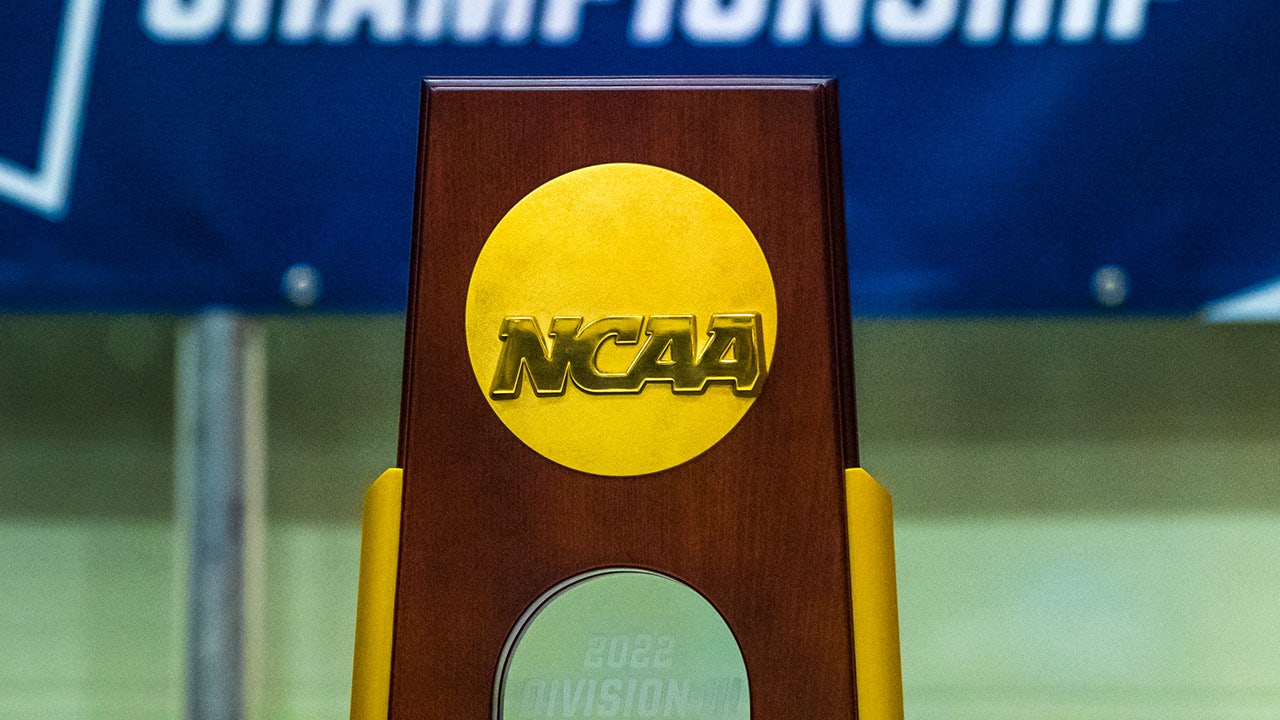
The NCAA and its power-five conferences filed a plan to pay out nearly $3 billion to former athletes in a settlement of an antitrust class-action lawsuit.
The proposed deal also paves the way for schools to directly compensate athletes while attempting to regulate payments from boosters.
“NCAA college athletes have waited decades for this moment, and their right to receive the full value of their hard work has finally arrived,” said Steve Berman, managing partner and co-founder of the Hagens Berman law firm. “We are incredibly proud to be in the final stages of historic change.”
Trophy and banner displayed during the NCAA Division III Women’s Ice Hockey Championship at Kenyon Arena on March 19, 2022, in Middlebury, Vermont. (Nancie Battaglia/NCAA Photos via Getty Images)
“College athletes will finally be able to share in the billions of dollars their compelling stories and dynamic performances have generated for their schools, conferences, and the NCAA,” the filing said. “This is nothing short of a seismic change to college sports following more than four years of hard-fought victories in this case.”
The $2.78 billion would be paid out over a 10-year period. Payouts will be determined based on the sport and length of athletic career, with most football and men’s basketball players able to receive nearly $135,000 each.
However, the highest estimated payout is expected to be nearly $2 million, thanks to “Lost NIL Opportunities,” according to the law firm.

A view of NRG Stadium as Nathan Mensah, #31 of the San Diego State Aztecs, and Adama Sanogo, #21 of the Connecticut Huskies, jump for the ball to start the game during the NCAA Men’s Basketball Tournament National Championship game at NRG Stadium on April 3, 2023, in Houston, Texas. (Logan Riely/Getty Images)
GEORGIA FOOTBALL STAR RODARIUS THOMAS BEING HELD WITHOUT BAIL AFTER ARREST ON FAMILY VIOLENCE CHARGES
The deal covers three antitrust cases — including the class-action lawsuit known as House vs. the NCAA — that challenged NCAA compensation rules dating to 2016. The plaintiffs claimed that NCAA rules denied thousands of athletes the opportunity to earn millions of dollars off the use of their names, images and likenesses.
The NCAA lifted its ban on athletes earning money through endorsement and sponsorship deals in 2021.
The agreement does not settle the issue of whether college athletes should be deemed employees, but it does include language that would suggest the deal would be subject to change if “a change in law or circumstances permits collective bargaining.”
“This settlement is an important step forward for student-athletes and college sports, but it does not address every challenge,” the commissioners of the Atlantic Coast Conference, Big Ten, Big 12, Pac-12, Southeastern Conference and NCAA President Charlie Baker said in a joint statement. “The need for federal legislation to provide solutions remains. If Congress does not act, the progress reached through the settlement could be significantly mitigated by state laws and continued litigation.”
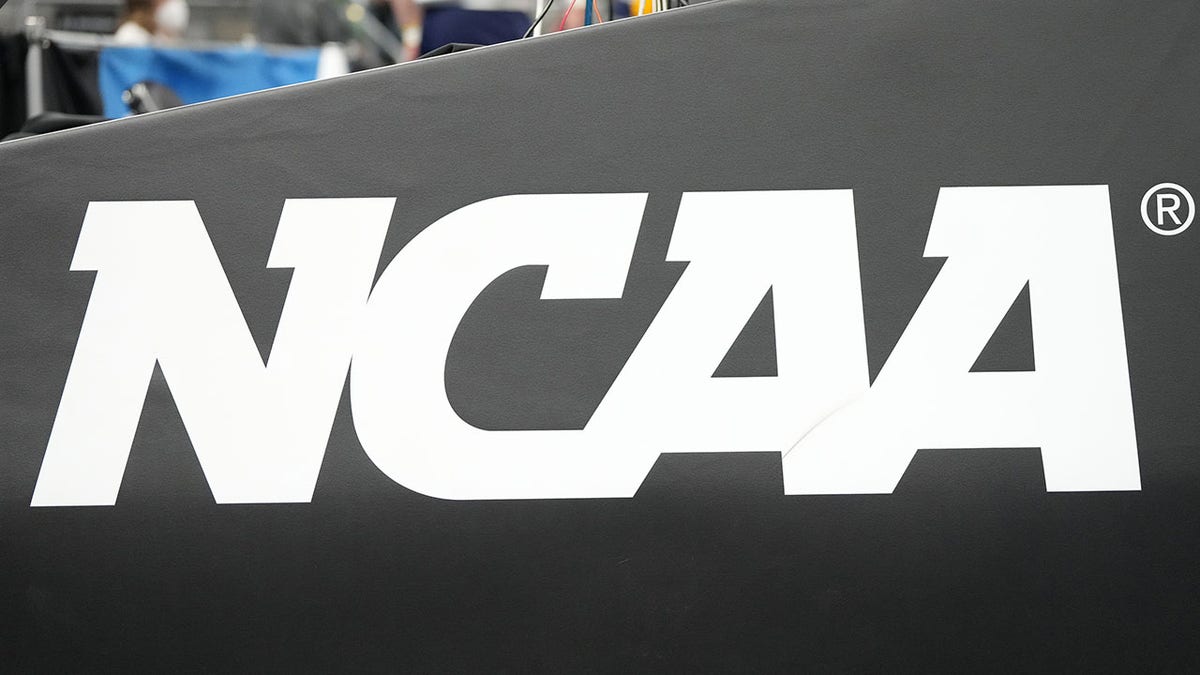
The NCAA logo shown on the basket pad before the Second Round NCAA Men’s Basketball Tournament game between the Marquette Golden Eagles and the Colorado Buffaloes at Gainbridge Fieldhouse on March 24, 2024, in Indianapolis, Indiana. (Mitchell Layton/Getty Images)
The filing still needs to be approved by a judge, but attorneys say they will file a motion for preliminary approval and, if granted, a public website will go up in about two months, where former college athletes can determine how much they are eligible to receive.
The Associated Press contributed to this report.
Follow Fox News Digital’s sports coverage on X, and subscribe to the Fox News Sports Huddle newsletter.
Sports
Swimming has a diversity problem. Can this generation of Olympians change that?
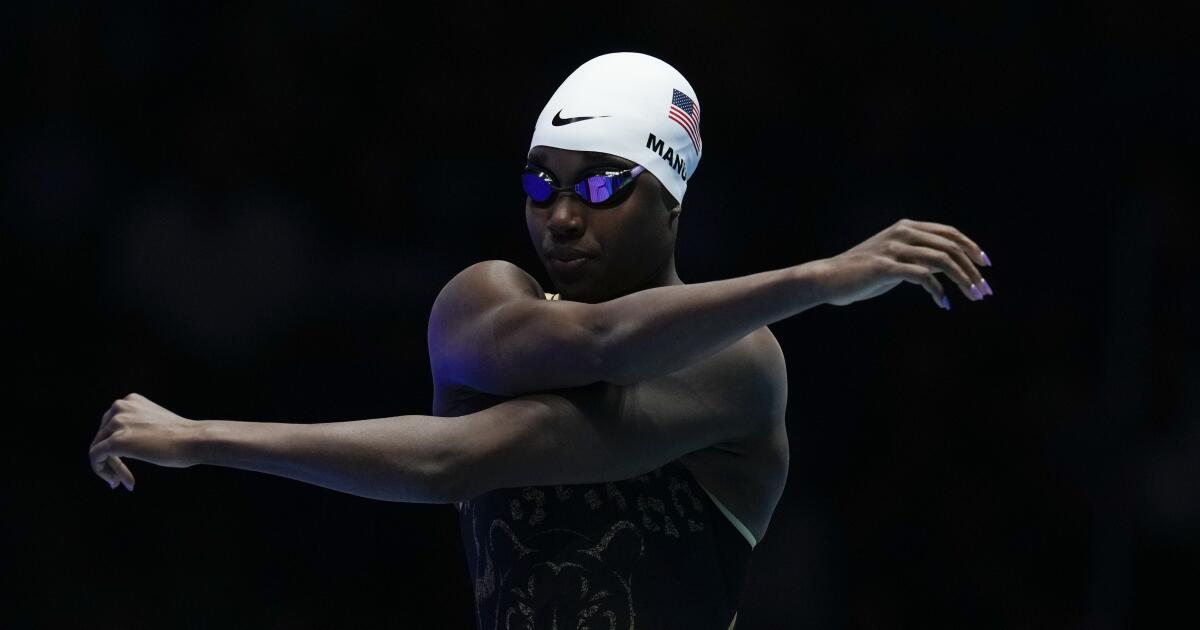
When Maritza Correia McClendon started swimming in Puerto Rico, she stood out because of her talent, not the color of her skin.
“There’s a lot of diversity in Puerto Rico,” said McClendon, who is Black and Latino, as are one in five people on the island.
Then her Guyanese-born parents moved to Florida when she was 8. Though she had become even faster in the pool, that was no longer the first thing people noticed about her.
“I remember a parent telling me, ‘What are you doing here? You should go do track or you should go on a basketball court,’” she said. “They were almost shaming me for being that outcast on that pool deck.
“That is definitely traumatizing. It’s still hard for me. I do definitely still struggle with that confidence factor.”
McClendon overcame that to become the first Puerto Rican of African descent to make the U.S. Olympic swimming team, the first Black female to win an Olympic medal for the U.S. and the first Black American swimmer to hold a world record.
2024 Paris Summer Olympic Games
In an effort to get others to follow her lead, McClendon is now among a growing number of former swimmers, coaches, officials and administrators working to make the sport more accessible and welcoming for people of color, from the grassroots level, where she was once shunned, to the Olympic team, where she shined.
The Paris Games has the opportunity to provide a big boost in those efforts when the swimming competition begins Saturday. Although only two of the 46 pool swimmers who will compete for the U.S. in Paris are Black — and none are Latino — those two, Shaine Casas, a three-time world champion, and Simone Manuel, a two-time Olympic champion and five-time Olympic medalist, have a chance to inspire a generation.
“If you’re not seeing somebody that you can relate to as a swimmer, then who’s going to be your role model?” said Steve Roush, executive director of Southern California Swimming, the grassroots affiliate of USA Swimming and the largest of the nation’s 59 local swim committees. “When you’ve seen over the last few years people like Simone Manuel, interests in the Black population say, ‘Hey, I guess we can swim. I guess there are spots for us.’ If they’ve never seen a Black on an Olympic or national team, then it’s really hard for them to think, ‘That’s what I want to do.’”
USA Swimming says less than 5% of the athletes registered with the federation are Black or Latino. Those groups account for 31% of the U.S. population. The level of representation on the Olympic team is no better. The reason for that has little to do with talent.
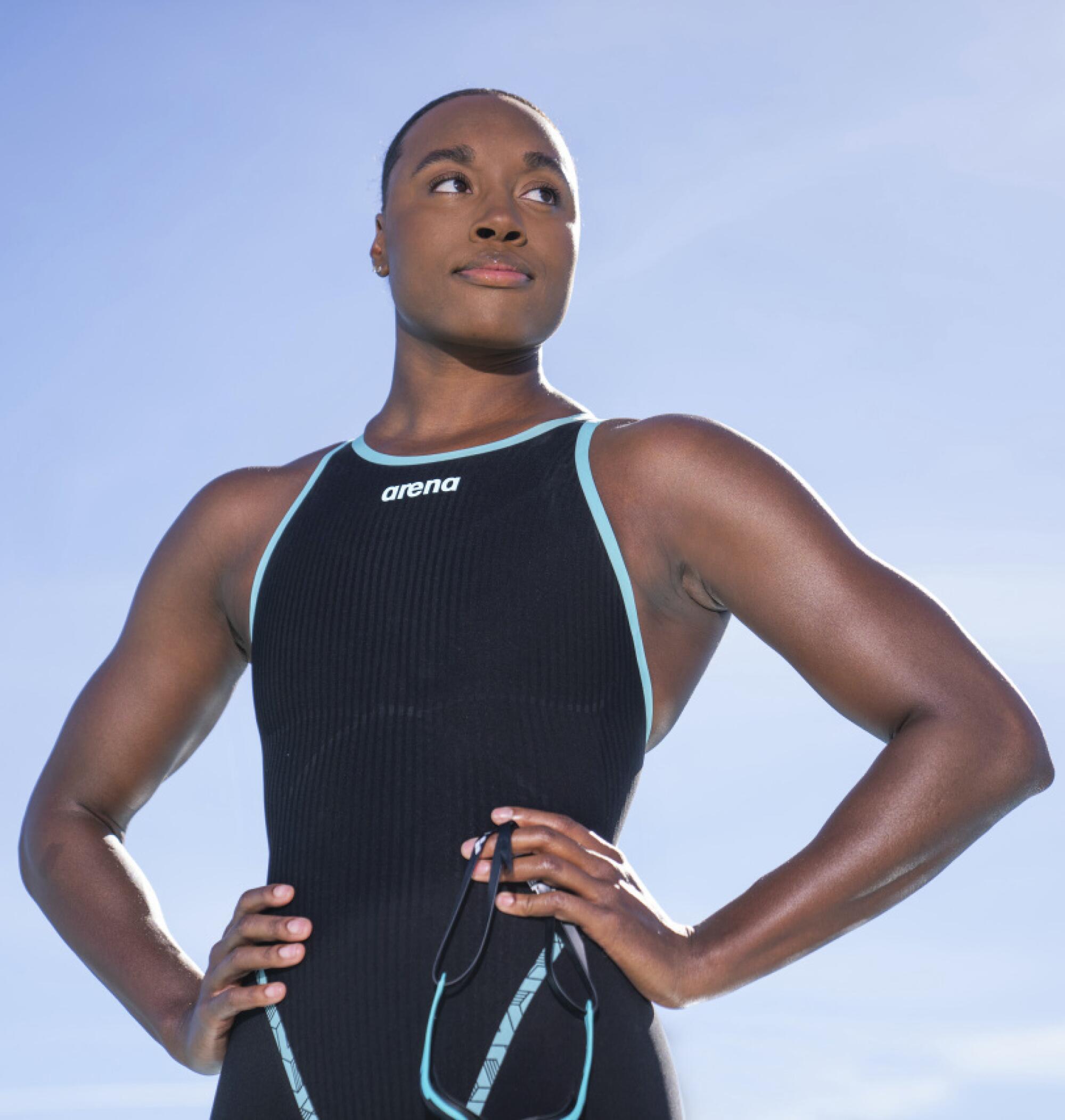
Simone Manuel will be competing in the women’s 50-meter freestyle at the Paris Games.
(Jack Spitzer / Associated Press)
“It’s not an athletic thing,” said Nic Askew, coach of the swim team at Howard University, the only HBCU to compete in the sport. “Anyone of any race and culture can be an amazing athlete in anything. But when you look at the history and the neglect, it absolutely is more social and socioeconomic.”
Until the last half of the 20th century, Black people and Latinos were commonly prohibited from using public pools and beaches. When those bans were lifted, the lack of swim facilities in inner-city neighborhoods became a new impediment to the sport.
“It’s very, very expensive,” McClendon said. “Not only for the person to learn how to swim, but also for the community to keep a pool open. The cost of the water, the chemicals, lifeguards. Every part of it tends to be very expensive.
“That’s a big hurdle. Another one is generational trauma. When our parents were growing up in segregation, they weren’t even allowed to go to the pool. So there became a fear of going to the water.”
That lack of access has had consequences that stretch beyond making an Olympic team. According to a 2021 study conducted by the USA Swimming Foundation and the University of Memphis, more than two-thirds of Black children do not know how to swim. The number is 45% for Latino children. As a result, the Centers for Disease Control and Prevention found the rate of drowning deaths among Black children aged 10-14 is 7.6% higher than whites of the same age while the rate for Latinos rose 25% between 2019 and 2022.
“Swimming,” McClendon said, “is the only sport that is also a life-saving skill.”
Yet as long as children of color don’t see themselves represented there, they will continue to believe swimming is not for them. That makes the Olympics — and especially the presence of athletes such as Casas, Manuel and Cullen Jones, the first Black American swimmer to break a world record — so important.
Casas, 24, a former world champion in the backstroke, will swim the 200 individual medley in Paris. That event begins Aug. 1. Manuel, who turns 28 next week, will swim the 4×100 freestyle relay Saturday and the individual 50 freestyle next week. She won gold medals in the 100 freestyle and the relay in Rio de Janeiro in 2016 and won a relay bronze in Tokyo three years ago.
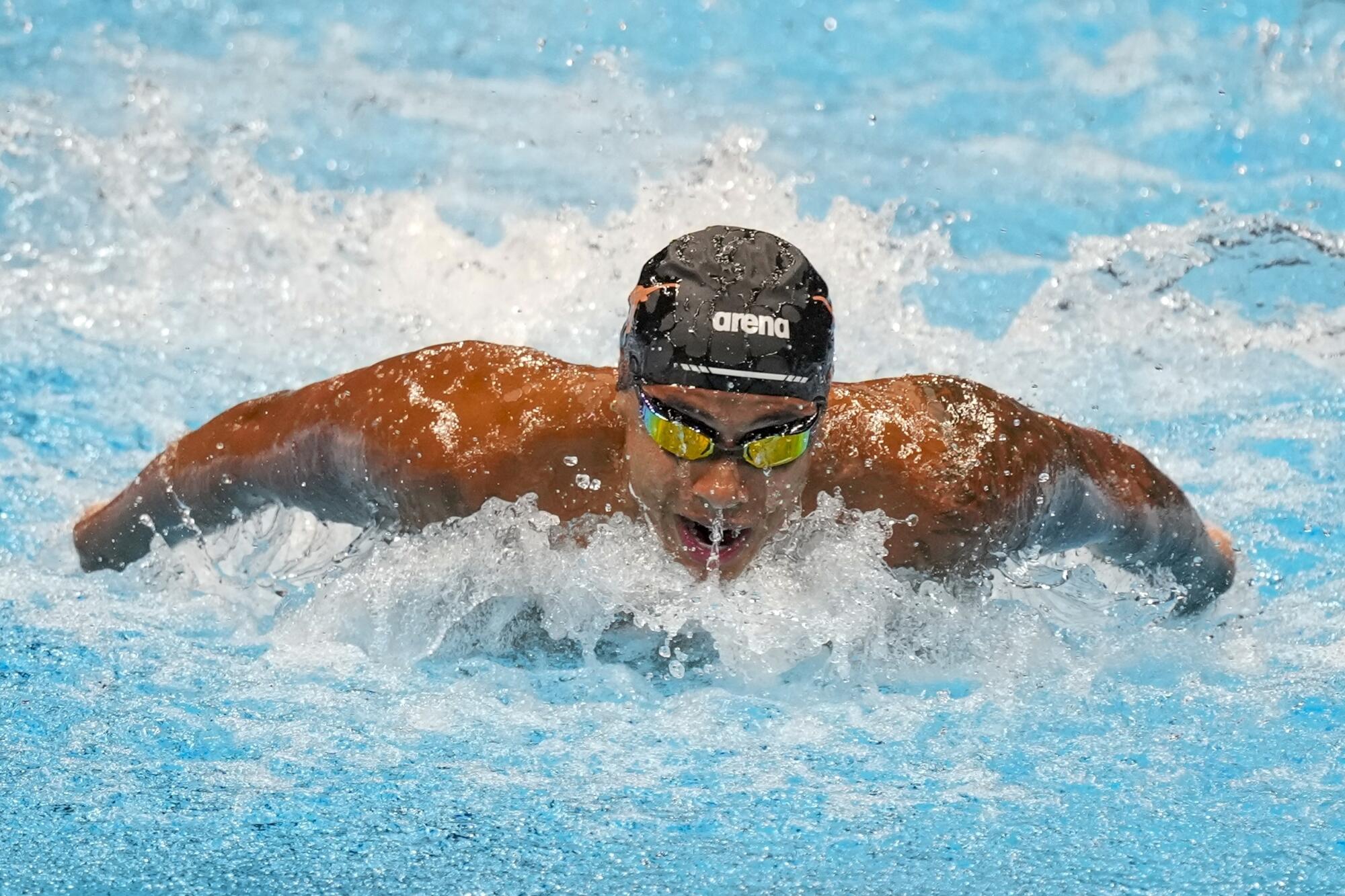
Shaine Casas swims during the men’s 200 individual medley preliminaries at the U.S. Olympic swimming trials in June.
(Michael Conroy / Associated Press)
If both can repeat their success in France, it could provide a big boost to make swimming more diverse in the U.S.
Progress is being made on other fronts as well. In Paris another barrier will fall — and another example will be created — when Anthony Nesty, a former gold medalist for Suriname and the coach at the University of Florida, becomes the first Black head coach of a U.S. Olympic men’s swim team. At the grassroots level, Roush said nearly a fifth of Southern California Swimming’s 20,000 athletes are Latino, a record for the region.
“The participation’s there,” he said. “I think we are reflective of the diverse ethnicity within Southern California. But these numbers aren’t reflective of what’s out there on the national scene.”
Making those numbers reflective of the population at large is important for a number of reasons, said Richard Lapchick, president of the Institute for Diversity and Ethics in Sport at the University of Central Florida.
Tennis, for example, shed its country club image when Serena and Venus Williams began to dominate the sport. That has not only brought more fans and more revenue to the sport, it has brought more and diverse participants as well, with the number of people playing the sport in the U.S. increasing by 33% between 2020 and 2023.
Not surprisingly that growth was most dramatic among people of color with the number of Latino players growing by 90% over that three-year period while Black participation increased by 46%.
“In any area, if you’re not raising a population that is representative of the entire country, you’re excluding [many] that could have been [great],” Lapchick said.
“Part of the reason why it would be helpful if [swimming] was more diverse, there are people who won’t pay attention to swimming because they look at it as a sport that’s exclusive rather than inclusive.”
Without the Williams sisters, we might never have gotten Coco Gauff. And without Black Olympic gymnastics champion Gabby Douglas, we might never have gotten Simone Biles. Over the next nine days, Casas and Manuel have a chance to do the same for Black and Latino swimmers. That opportunity is a fleeting one that only comes around once every four years.
“The one time historically that swimming is at the top of the media or a topic of conversation is during the Olympics,” Askew said. “But the Olympic cycle is every four years. So to be able to see athletes like Shaine and Simone now, it’s phenomenal.
“This is a space that a Black person can be at this elite level.”
-

 World1 week ago
World1 week agoOne dead after car crashes into restaurant in Paris
-

 Midwest1 week ago
Midwest1 week agoMichigan rep posts video response to Stephen Colbert's joke about his RNC speech: 'Touché'
-

 News1 week ago
News1 week agoVideo: Young Republicans on Why Their Party Isn’t Reaching Gen Z (And What They Can Do About It)
-

 Movie Reviews1 week ago
Movie Reviews1 week agoMovie Review: A new generation drives into the storm in rousing ‘Twisters’
-

 Politics1 week ago
Politics1 week agoFox News Politics: The Call is Coming from Inside the House
-

 News1 week ago
News1 week agoVideo: J.D. Vance Accepts Vice-Presidential Nomination
-

 World1 week ago
World1 week agoTrump to take RNC stage for first speech since assassination attempt
-

 News1 week ago
News1 week agoRNC speakers want to separate the president from the person to show softer side of Trump










